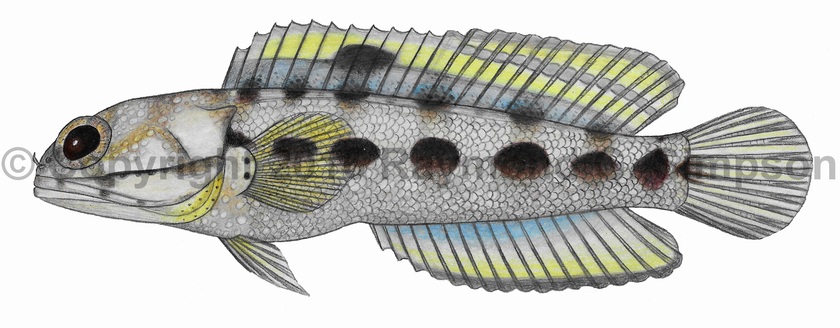
Common Name
Banded Jawfish
Year Described
Poey, 1860
Identification
Dorsal Fin: X-XII, 15-17
Anal Fin: II-III, 15-16
Pelvic Fin: I, 5
Pectoral Fin: 19-22
Gill Rakers: 31-43 (total)
Vertebrae: 10 precaudal, 18-20 caudal; 28-30 total
Maxilla of males with thin, flexible posterior extension. Jaws huge; reaching well past rear margin of orbit. Premaxillary and dentary with teeth. Vomer with 1-2 teeth. Lateral line extends posteriorly to between 2nd and 7th segmented dorsal ray. Nape, head, pectoral base, and area above lateral line scaleless. Rest of body fully scaled. Lateral scale rows: 72-95. Dorsal fin spines slender with sharp, flexible tips. Anterior nostril with a short cirrus.
Color
Body mottled in various shades of light to medium brown. A series of several large dark blotches run along the side and range from separate to fused into a stripe. Another series of dark blotches along the dorsum run onto dorsal fin. Head with dark blotches and small spots. Males with two bands on the inner maxilla (one in females). Dorsal fin banded in pale brown with a bluish cast anteriorly and yellowish cast on the distal margin of the soft portion. A small dark blotch between dorsal spines 7 and 8. There are two lines of pale spots on the dorsal fin and scattered pale spots on the anal fin. Anal and caudal fin bluish with a yellowish distal region. Pelvic fin bluish. Pectoral fin yellowish with black speckles.
Size
The largest W. Atlantic jawfish: maximum size to 166mm SL.
Habitat
Found on sand and rubble bottoms from 0-44m. Inhabits burrows.
Range
Florida to N. South America, including the Caribbean islands.
References
Smith-Vaniz, W. F. 1997. Five new species of jawfishes (Opistognathus: Opistognathidae) from the western Atlantic Ocean. Bulletin of Marine Science v. 60 (3): 1074-1128.